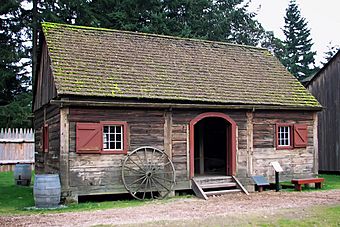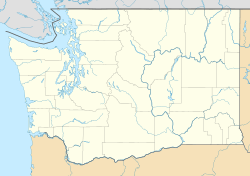Fort Nisqually facts for kids
Quick facts for kids |
|
|
Fort Nisqually Site
|
|
| Location | NW of Dupont off I-5 |
|---|---|
| Nearest city | DuPont, Washington |
| NRHP reference No. | 74001971 |
| Added to NRHP | October 16, 1974 |
|
Fort Nisqually Granary
|
|
 |
|
| Location | Point Defiance Park Tacoma, Washington |
|---|---|
| Area | 726 square feet |
| NRHP reference No. | 70000647 |
| Significant dates | |
| Added to NRHP | April 15, 1970 |
| Designated NHL | April 15, 1970 |
Fort Nisqually was a very important place for trading furs and farming. It was run by the Hudson's Bay Company. This company was a big business that traded furs across Canada and parts of the United States. Fort Nisqually was located in what is now DuPont, Washington.
Today, Fort Nisqually is a fun living history museum. It is in Tacoma, Washington, inside Point Defiance Park. You can visit and see what life was like long ago! The Fort Nisqually Granary is a special building. It was moved from the original fort site to Point Defiance Park. It is a U.S. National Historic Landmark. Built in 1843, the granary is the oldest building in Washington state. It is also one of the only remaining buildings built in a special "post-and-plank" style by the Hudson's Bay Company. The Granary and the Factor's House are the only original Hudson's Bay Company buildings left in the United States.
Contents
Building the Fort: A New Trading Post
The Hudson's Bay Company wanted to expand its fur trading business. They moved west and created the Columbia District. This area covered what Americans called the Oregon Country. The company built forts in places where many different Native American tribes could easily trade furs.
In 1824, Fort Vancouver was built near the Columbia River. Later, Fort Langley was built in 1827 on the Fraser River. To connect these forts, a shortcut route called the Cowlitz Portage was made. This route was very important for travel and trade. After some dangerous events on this route, the company decided they needed a fort in the middle for safety.
The new spot chosen was Nisqually. It was a great choice because ships could anchor there easily. It was also good for overland travel. The local tribes were friendly, and there were open fields for animals and crops. In April 1832, a small warehouse called Nisqually House was built. It was 15 by 20 feet. Only three men stayed there to manage supplies. This was the first European trading post on the Puget Sound.
Life and Work at Fort Nisqually
In May 1833, Archibald McDonald and William Fraser Tolmie came with seven men. They started building a stronger, permanent fort. Tolmie stayed for a year and wrote many things about the area. The men often relied on nearby Native American villages for food. They did not find much game to hunt themselves.
Friendships grew with the local Indigenous people. The fort's officers met with Chief Gray Head of the Steilacooms in 1833. Trading also began with the nearby Puyallup tribe and the S'Klallams.
Many different people worked at Fort Nisqually. There were Scottish gentlemen, Native Americans, Hawaiian Kanakas, French-Canadians, Métis, people from the West Indies, and Englishmen. Later, some Americans also worked there. Fort Nisqually grew from a small trading post to a major international trading center.
The main product traded at the fort was beaver pelts. These furs were used to make fancy top hats. Over the years, the fort collected thousands of beaver, muskrat, raccoon, and river otter furs.
Farming and Livestock at the Fort
In 1840, a new company was formed called the Pugets Sound Agricultural Company (PSAC). It was a part of the Hudson's Bay Company. This new company focused on farming and raising animals. Fort Nisqually and Cowlitz Farm became part of this new farming effort. Hudson's Bay Company staff still managed them.
In 1841, many Métis families from the Red River colony came to work for the PSAC. They became farmers and ranchers at Fort Nisqually and Cowlitz Farm. Fourteen families chose Fort Nisqually as their new home. In 1843, the fort was moved closer to Edmonds Marsh and Sequalitchew Creek. This gave them better access to water and timber.
Fort Nisqually began to export livestock and crops. They sent goods to places like Russian Alaska, the Kingdom of Hawaii, and Alta California. By 1845, they had over 2,000 cattle, originally from Mexico. These cattle supplied many Hudson's Bay Company forts. The fort also had large flocks of sheep. These sheep were special breeds known for their wool. By 1845, there were almost 6,000 sheep.
William Fraser Tolmie managed the PSAC from 1843 to 1857. He oversaw all the farming and animal projects from Fort Nisqually. He was in charge during a big change. Control of the area shifted from British to American hands after the Oregon Treaty in 1846. Tolmie was well-respected by everyone: the British, Indigenous peoples, and American settlers.
What the Fort Looked Like
In 1843, a Catholic missionary named Jean Bolduc visited the fort. He described it as having: "an enclosure of fir logs, on an average eighteen feet high, enclosing a space one hundred fifty feet on each side and having a small unarmed bastion at the four corners. Inside is a house for the superintendent, a store for trading in furs and several small buildings for the lodging of servitors and voyageurs."
This means the fort had tall wooden walls made of fir logs. It was a square, about 150 feet on each side. There were small towers called bastions at each corner. Inside, there was a house for the manager, a store for trading furs, and smaller buildings for workers and travelers to live in.
Changes and Closure of the Fort
The Oregon Treaty of 1846 set the border between the United States and British North America. The border was set at the 49th parallel. This meant Fort Nisqually was now on American land.
Many American settlers started arriving in the 1850s. They came to claim land. These new settlers often depended on Fort Nisqually for food and supplies. They traded their farm goods for what they needed. However, some American settlers tried to take parts of the fort's land. In 1851, there were 28 attempts to take land. Two years later, there were 50 such incidents. The fort's animals were also targeted. An officer reported in 1854 that Americans were "constantly about the plains killing our beef."
Because the fur trade was slowing down and there were more problems with American settlers and tax collectors, Fort Nisqually closed in 1869. A former employee named Edward Huggins became an American citizen. He took over the site as his own homestead.
Fort Nisqually Managers
| Manager | Position | Years |
|---|---|---|
| Francis Heron | Chief Trader | 1833–1834 |
| William Kittson | Clerk | 1834–1840 |
| Alexander C. Anderson | Clerk | 1840–1841 |
| Joseph T. Heath | 1841 | |
| William Henry McNeill | Chief Trader | 1841–1842 |
| Angus McDonald | Postmaster | 1842–1843 |
| William Fraser Tolmie | Clerk | 1843–1847 |
| William Fraser Tolmie | Chief Trader | 1847–1855 |
| William Fraser Tolmie | Chief Factor | 1855–1859 |
| Edward Huggins | Clerk | 1859–1870 |
Bringing the Fort Back to Life

In the 1930s, people decided to rebuild Fort Nisqually. They chose a new location: Point Defiance Park in Tacoma, Washington. This park is about 15 miles from the original fort site. This rebuilding project was part of President Franklin Roosevelt's New Deal program. This program helped create jobs during the Great Depression. The WPA and the Tacoma Businessmen's Association helped fund this effort.
Only two original buildings were moved: the granary and the factor's house. The other buildings at the original site had fallen apart. They could not be moved.
The Fort Nisqually Granary was named a National Historic Landmark in 1970.
Fort Nisqually Today
Today, the restored Fort Nisqually is a living history museum. Employees and volunteers work there. They help visitors learn about the past. Two of the original buildings are still there: the Factor's House and the Granary.
The museum also has other buildings. There is a trade store, a working blacksmith shop, and a house where laborers lived. You can also see a laundry, a root cellar, a demonstration kitchen, and a kitchen garden.
Fort Nisqually has been updated to look more like it did long ago. The Factor's House was restored. Two bastions (towers) from the 1830s were moved and restored. A part of the fort's wall now looks like the wall from 1847.
In 1988–89, archaeologists studied the site. They found hundreds of old items. These items helped them learn more about the fort's history. Much research has also been done using old journals and letters from Edward Huggins. Huggins was a clerk for the Hudson's Bay Company. He arrived in 1850. He later became an American citizen and lived on the fort's land until he passed away in 1906. Metro Parks Tacoma manages the restored fort today.
The original 1833 fort location is now part of The Home Course golf course in DuPont. The 1843 location in DuPont, where the Granary and Factor's House originally stood, is owned by The Archaeological Conservancy. The DuPont Historical Society manages it. This site is usually closed to the public. However, it opens for a special Fort Nisqually celebration each year. You can still see a line of black locust trees there. These trees were planted in the 1850s and are the only visible remains of the original fort. The DuPont History Museum has information about the fort and items from the Hudson's Bay Company.
See also
- List of the oldest buildings in Washington (state)


